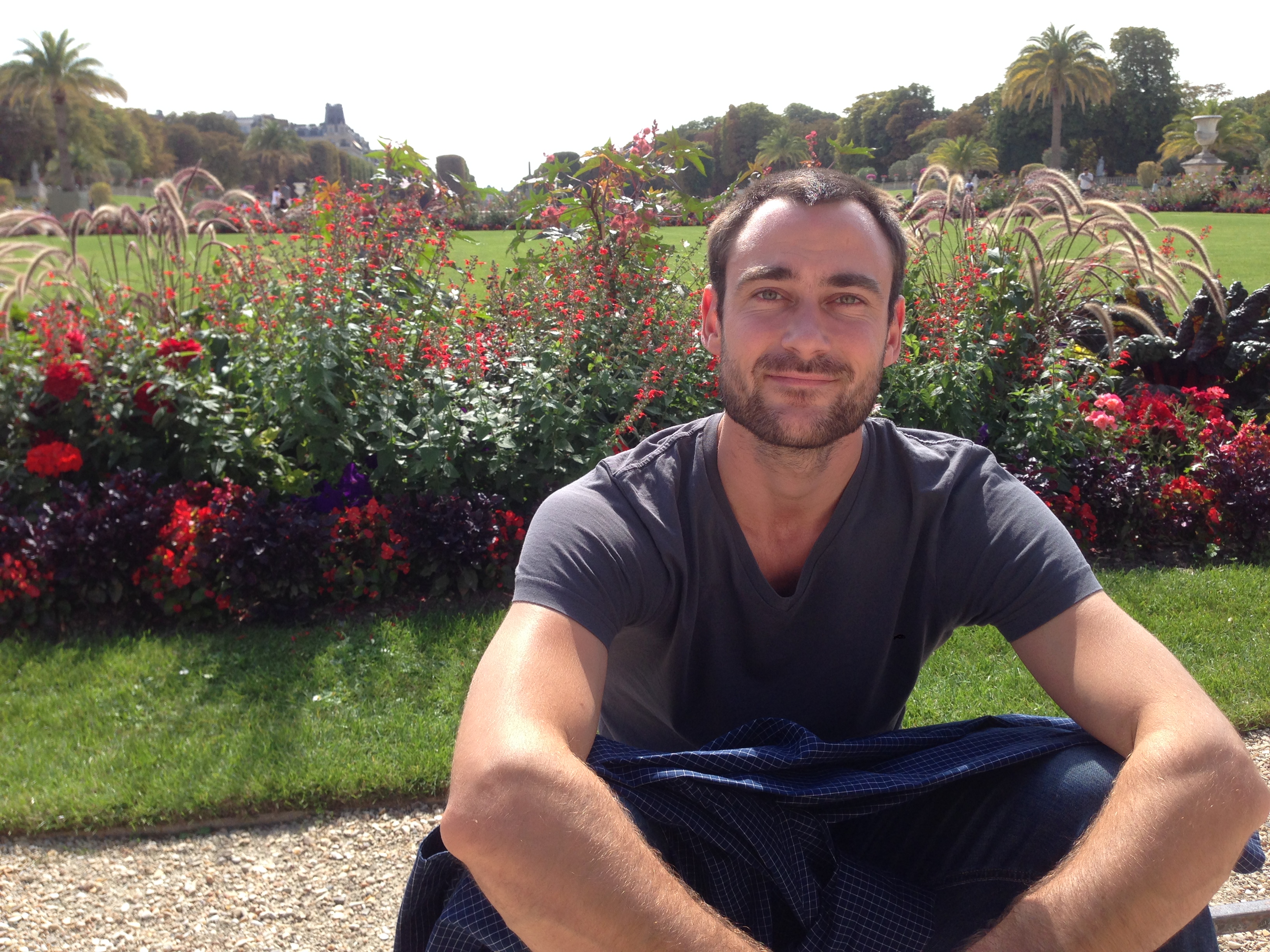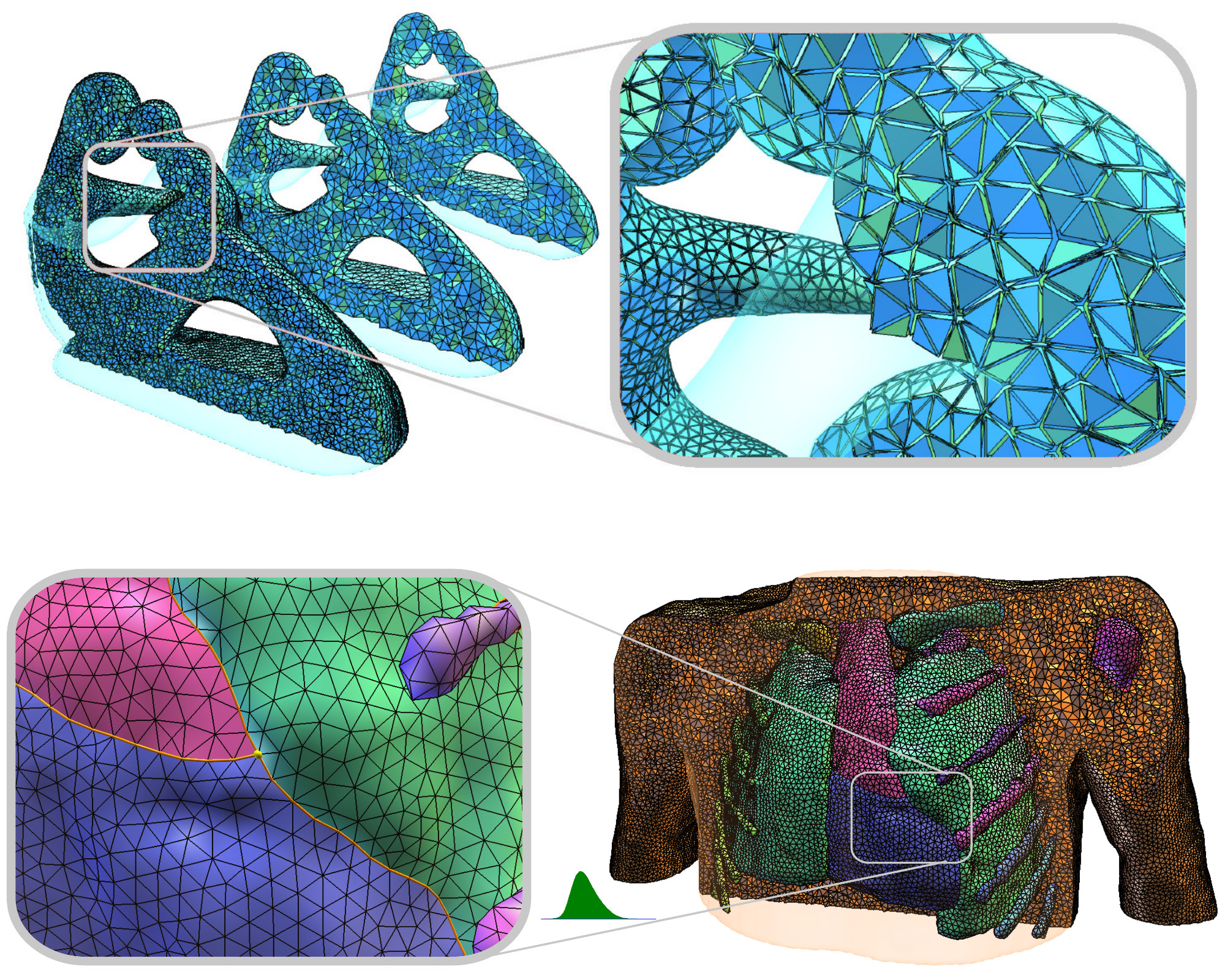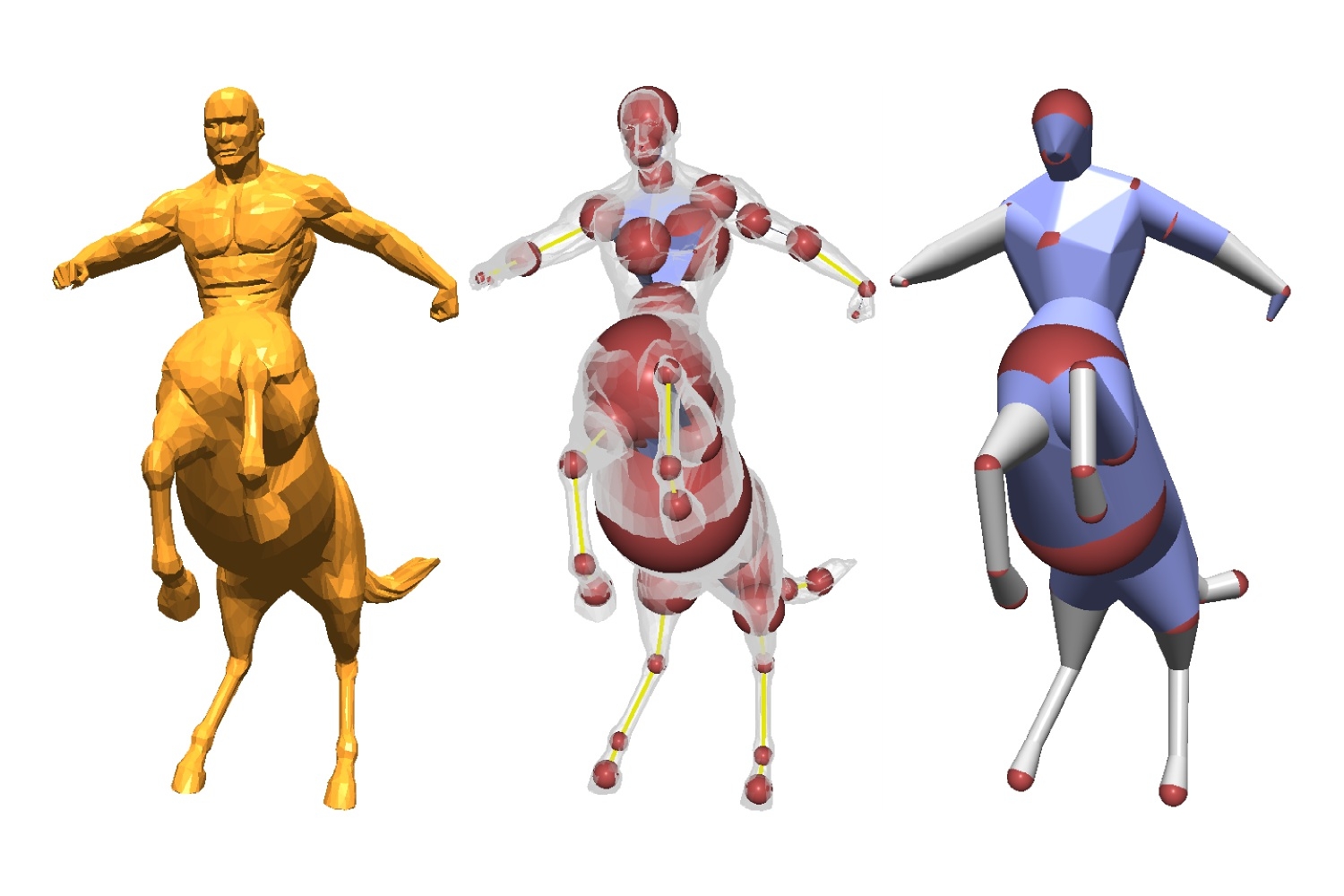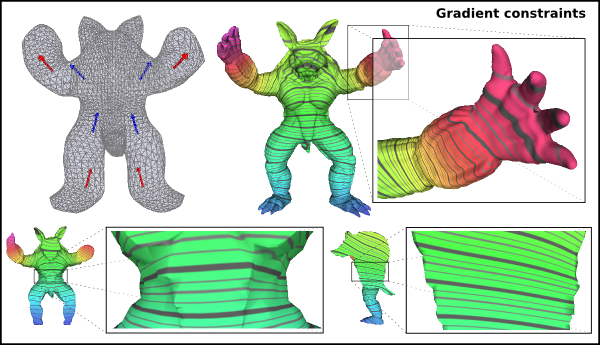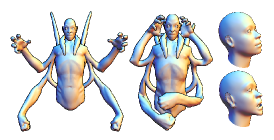Skeleton-based and cage-based deformation techniques represent the two most popular approaches to control real-time defor-
mations of digital shapes and are, to a vast extent, complementary to one another. Despite their complementary roles, high-end
modeling packages do not allow for seamless integration of such control structures, thus inducing a considerable burden on
the user to maintain them synchronized. In this paper, we propose a framework that seamlessly combines rigging skeletons and
deformation cages, granting artists with a real-time deformation system that operates using any smooth combination of the two
approaches. By coupling the deformation spaces of cages and skeletons, we access a much larger space, containing poses that
are impossible to obtain by acting solely on a skeleton or a cage. Our method is oblivious to the specific techniques used to
perform skinning and cage-based deformation, securing it compatible with pre-existing tools. We demonstrate the usefulness of
our hybrid approach on a variety of examples.
Fabrizio Corda,
Jean-Marc Thiery,
Marco Livesu,
Enrico Puppo,
Tamy Boubekeur,
Riccardo Scateni
Computer Graphics Forum 2020
The spectrum of the Laplace-Beltrami operator is instrumental for a number of geometric modeling applications, from processing
to analysis. Recently, multiple methods were developed to retrieve an approximation of a shape that preserves its eigenvectors
as much as possible, but these techniques output a subset of input points with no connectivity, which limits their potential
applications. Furthermore, the obtained Laplacian results from an optimization procedure, implying its storage alongside
the output selected points: focusing on keeping a mesh instead of an operator would allow to retrieve the latter using the
standard cotangent formulation, enabling easier processing afterwards. Instead, we propose to simplify the input mesh using a
spectrum-preserving mesh decimation scheme, so that the Laplacian computed on the simplified mesh is spectrally close to the
one of the input mesh. We illustrate the benefit of our approach for quickly approximating spectral distances and functional maps
on low resolution proxies of potentially high resolution input meshes.
Thibault Lescoat,
Hsueh-Ti Derek Liu,
Jean-Marc Thiery,
Alec Jacobson,
Tamy Boubekeur,
Maks Ovsjanikov
Computer Graphics Forum -- proceedings of Eurographics 2020
We present a method for constructing a surface mesh filling gaps between the boundaries of multiple disconnected input components. Unlike previous works, our method pays special attention to preserving both the connectivity and large-scale geometric features of input parts, while maintaining efficiency and scalability w.r.t. mesh complexity. Starting from an implicit surface reconstruction matching the parts' boundaries, we first introduce a modified dual contouring algorithm which stitches a meshed contour to the input components while preserving their connectivity. We then show how to deform the reconstructed mesh to respect the boundary geometry and preserve sharp feature lines, smoothly blending them when necessary. As a result, our reconstructed surface is smooth and propagates the feature lines of the input. We demonstrate on a wide variety of input shapes that our method is scalable to large input complexity and results in superior mesh quality compared to existing techniques.
Thibault Lescoat,
Pooran Memari,
Jean-Marc Thiery,
Maks Ovsjanikov,
Tamy Boubekeur
Pacific Graphics 2019 -- short paper session
Dans cet article, nous nous intéressons à l'appariement difféomorphique de faisceaux du cerveau. Ce problème est complexe car deux faisceaux n'ont presque jamais le même nombre de fibres. Ces variations topologiques peuvent détériorer les déformations obtenues et fausser les interprétations cliniques. Nous proposons ici une méthode robuste aux différences topologiques, grâce à la combinaison de normes Lp et de métriques à noyaux adaptées à l'espace des fibres. Les résultats sur des exemples jouets et sur des données réelles sont prometteurs.
Pierre Roussillon, Jean-Marc Thiery, Isabelle Bloch, Pietro Gori
GRETSI 2019 (Colloque francophone de traitement du signal et des images)
Modern 3D capture pipelines produce dense surface meshes at high speed, which challenge geometric operators to process
such massive data on-the-fly. In particular, aiming at instantaneous feature-preserving smoothing and clustering disqualifies
global variational optimizers and one usually relies on high performance parallel kernels based on simple measures performed
on the positions and normal vectors associated with the surface vertices. Although these operators are effective on small
supports, they fail at properly capturing larger scale surface structures. To cope with this problem, we propose to enrich the
surface representation with filtered quadrics, a compact and discriminating range space to guide processing. Compared to
normal-based approaches, this additional vertex attribute significantly improves feature preservation for fast bilateral filtering
and mode-seeking clustering, while exhibiting a linear memory cost in the number of vertices and retaining the simplicity of
convolutional filters. In particular, the overall performance of our approach stems from its natural compatibility with modern
fine-grained parallel computing architectures such as graphics processor units (GPU). As a result, filtered quadrics offer a
superior ability to handle a broad spectrum of frequencies and preserve large salient structures, delivering meshes on-the-fly
for interactive and streaming applications, as well as quickly processing large data collections, instrumental in learning-based
geometry analysis.
Hélène Legrand,
Jean-Marc Thiery,
and Tamy Boubekeur
Computer Graphics Forum 2019 -- presented at Eurographics 2019
Mean value coordinates for quad cages in 3D
Space coordinates offer an elegant, scalable and versatile framework to propagate (multi-)scalar functions from the boundary vertices of a 3-manifold, often called a cage, within its volume. These generalizations of the barycentric coordinate system have progressively expanded the range of eligible cages to triangle and planar polygon surface meshes with arbitrary topology, concave regions and a spatially-varying sampling ratio, while preserving a smooth diffusion of the prescribed on-surface functions. In spite of their potential for major computer graphics applications such as freeform deformation or volume texturing, current space coordinate systems have only found a moderate impact in applications. This follows from the constraint of having only triangles in the cage most of the time, while many application scenarios favor arbitrary (non-planar) quad meshes for their ability to align the surface structure with features and to naturally cope with anisotropic sampling. In order to use space coordinates with arbitrary quad cages currently, one must triangulate them, which results in large propagation distortion. Instead, we propose a generalization of a popular coordinate system, Mean Value Coordinates, to quad and tri-quad cages, bridging the gap between high-quality coarse meshing and volume diffusion through space coordinates. Our method can process non-planar quads, comes with a closed-form solution free from global optimization and reproduces the expected behavior of Mean Value Coordinates, namely smoothness within the cage volume and continuity everywhere. As a result, we show how these coordinates compare favorably to classical space coordinates on triangulated quad cages, in particular for freeform deformation.
Jean-Marc Thiery,
Pooran Memari,
and Tamy Boubekeur
Transactions on Graphics - proceedings of Siggraph Asia 2018
Current tractography methods generate tractograms composed of millions of 3D polylines, called fibers, making visualization and interpretation extremely challenging, thus complexifying the use of this technique in a clinical environment. We propose to progressively simplify tractograms by grouping similar fibers into generalized cylinders. This produces a fine-grained multi-resolution model that provides a progressive and real-time navigation through different levels of detail. This model preserves the overall structure of the tractogram and can be adapted to different measures of similarity. We also provide an efficient implementation of the method based on a Delaunay tetrahedralization. We illustrate our method using the
Human Connectome Project dataset.
Corentin Mercier,
Pietro Gori,
Damien Rohmer,
Marie-Paule Cani,
Tamy Boubekeur,
Jean-Marc Thiery,
and Isabelle Bloch
EG VCBM, Eurographics Workshop, 2018
Dictionaries are very useful objects for data analysis, as they enable a compact representation of large sets of objects through the combination of atoms. Dictionary-based techniques have also particularly benefited from the recent advances in machine learning, which has allowed for data-driven algorithms to take advantage of the redundancy in the input dataset and discover relations between objects without human supervision or hard-coded rules. Despite the success of dictionary-based techniques on a wide range of tasks in geometric modeling and geometry processing, the literature is missing a principled state-of-the-art of the current knowledge in this field. To fill this gap, we provide in this survey an overview of data-driven dictionary-based methods in geometric modeling. We structure our discussion by application domain: surface reconstruction, compression, and synthesis. Contrary to previous surveys, we place special emphasis on dictionary-based methods suitable for 3D data synthesis, with applications in geometric modeling and design. Our ultimate goal is to enlight the fact that these techniques can be used to combine the data-driven paradigm with design intent to synthesize new plausible objects with minimal human intervention. This is the main motivation to restrict the scope of the present survey to techniques handling point clouds and meshes, making use of dictionaries whose definition depends on the input data, and enabling shape reconstruction or synthesis through the combination of atoms.
Thibault Lescoat,
Maks Ovsjanikov,
Pooran Memari,
Jean-Marc Thiery,
and Tamy Boubekeur
Computer Graphics Forum 2018 - proceedings of Eurographics 2018 - state of the art report session
We present a fast, robust and high-quality technique to skin a mesh with reference to a skeleton. We consider
the space of possible skeleton deformations (based on skeletal constraints, or skeletal animations), and compute
skinning weights based on an optimization scheme to obtain as-rigid-as-possible (ARAP) corresponding mesh deformations.
We support stretchable-and-twistable bones (STBs) and spines by generalizing the ARAP deformations
to stretchable deformers. Additionally, our approach can optimize joint placements. If wanted, a user can guide
and interact with the results, which is facilitated by an interactive feedback, reached via an efficient sparsification
scheme. We demonstrate our technique on challenging inputs (STBs and spines, triangle and tetrahedral meshes
featuring missing elements, boundaries, self-intersections, or wire edges).
Jean-Marc Thiery and Elmar Eisemann
Computer Graphics Forum 2017
We propose a novel framework for photometric
stereo (PS) under low-light conditions using uncalibrated near-
light illumination. It operates on free-form video sequences captured with a minimalistic and affordable setup. We address issues
such as albedo variations, shadowing, perspective projections and
camera noise. Our method uses specular spheres detected with a
perspective-correcting Hough transform to robustly triangulate
light positions in the presence of outliers via a least-squares
approach. Furthermore, we propose an iterative reweighting
scheme in combination with an l_p-norm minimizer to robustly
solve the calibrated near-light PS problem. In contrast to other
approaches, our framework reconstructs depth, albedo (relative
to light source intensity) and normals simultaneously and is
demonstrated on synthetic and real-world scenes.
Jingtang Liao, Bert Buchholz, Jean-Marc Thiery, Pablo Bauszat, and Elmar Eisemann
Transactions on Image Processing 2017
We propose a practical iterative remeshing algorithm for multi-material tetrahedral meshes which is solely based on simple local
topological operations, such as edge collapse, flip, split and vertex smoothing. To do so, we exploit an intermediate implicit feature
complex which reconstructs piecewise smooth multi-material boundaries made of surface patches, feature edges and corner vertices.
Futhermore, we design specific feature-aware local remeshing rules which, combined with a moving least square projection, result
in high quality isotropic meshes representing the input mesh at a user defined resolution while preserving important features. Our
algorithm uses only topology-aware local operations, which allows to process difficult input meshes such as self-intersecting ones.
We evaluate our approach on a collection of examples and experimentally show that it is fast and scales well.
Noura Faraj, Jean-Marc Thiery, and Tamy Boubekeur
Computer & Graphics 2016 - proceedings of Shape Modeling International 2016 - Best paper award
Performance capture systems are used to acquire high-quality animated 3D
surfaces, usually in form of a dense 3D triangle mesh. Extracting a more
compact, yet faithful representation is often desirable, but existing solutions
for animated sequences are surface-based, which leads to a limited approximation
power in the case of extreme simplification. We introduce animated
sphere-meshes, which are meshes indexing a set of animated spheres. Our
solution is the first to output an animated volumetric structure to approximate
animated 3D surfaces and optimizes for the sphere approximation,
connectivity, and temporal coherence. As a result, our algorithm produces
a multi-resolution structure from which a level of simplification can be selected
in real-time, preserving a faithful approximation of the input, even at
the coarsest levels. We demonstrate the use of animated sphere-meshes for
low-cost approximate collision detection. Additionally, we propose a skinning
decomposition, which automatically rigs the input mesh to the chosen
level of detail. The resulting set of weights are smooth, compress the animation,
and enable easy edits.
Jean-Marc Thiery, Emilie Guy, Tamy Boubekeur and Elmar Eisemann
Transactions On Graphics 2016 - presented at Siggraph 2016
Voxel-based approaches are today's standard to encode volume data. Recently, directed acyclic graphs (DAGs) were success-
fully used for compressing sparse voxel scenes as well, but they are restricted to a single bit of (geometry) information per voxel.
We present a method to compress
arbitrary
data, such as colors, normals, or reflectance information. By decoupling geometry
and voxel data via a novel mapping scheme, we are able to apply the DAG principle to encode the topology, while using a
palette-based compression for the voxel attributes, leading to a drastic memory reduction. Our method outperforms existing
state-of-the-art techniques and is well-suited for GPU architectures. We achieve real-time performance on commodity hardware
for colored scenes with up to
17
hierarchical levels (a
128
K^3
voxel resolution), which are stored fully in core.
Bas Dado, Timothy R. Kol, Pablo Bauszat, Jean-Marc Thiery, Elmar Eisemann
Computer Graphics Forum - proceedings of Eurographics 2016
Mean Shift is a well-known clustering algorithm that
has attractive properties such as the ability to find non convex and
local clusters even in high dimensional spaces, while remaining
relatively insensitive to outliers. However, due to its poor computational
performance, real-world applications are limited. In this
article, we propose a novel acceleration strategy for the traditional
Mean Shift algorithm, along with a two-layers strategy, resulting
in a considerable performance increase, while maintaining high
cluster quality.We also show how to to find clusters in a streaming
environment with bounded memory, in which queries need to be
answered at interactive rates, and for which no mean shift-based
algorithm currently exists. Our online structure can be updated
at very minimal cost and as infrequently as possible, and we
show how to detect the time at which this update needs to be
performed. Our technique is validated extensively in both static
and streaming environments.
Daniel van der Ende, Jean-Marc Thiery and Elmar Eisemann
DATA ANALYTICS 2015, The Fourth International Conference on Data Analytics - Best paper award in session "Big Data"
Surface selection is one of the fundamental cornerstone interaction in shape modeling. In the case of complex models, this task is often tedious for at least two reasons: first the local geometry of a given region may be hard to select manually and needs great accuracy; second the selection process may have to be repeated a large number of times for similar regions requiring similar subsequent editing. We propose SimSelect, a new system for interactive selection on 3D surfaces addressing these two issues. We cope with the accuracy issue by classifying selection in different types namely components, parts and patches for which we independently optimize. Second, we address the repetitivity issue by introducing an expansion process based on shape recognition which automatically retrieves potential selections similar to the user-defined one. As a result, our system provides the user with a compact set of simple interaction primitives leveraging a smooth select-and-edit workflow.
Emilie Guy, Jean-Marc Thiery and Tamy Boubekeur
Computer Graphics Forum - proceedings of Eurographics 2014
The Scale Axis Transform provides a parametric simplification of
the Medial Axis of a 3D shape which can be seen as a hierarchical
description. However, this powerful shape analysis method has a
significant computational cost, requiring several minutes for a single scale on a mesh of few thousands vertices.
Moreover, the scale
axis can be artificially complexified at large scales, introducing new
topological structures in the simplified model. In this paper, we
propose a progressive medial axis simplification method inspired
from surface optimization techniques which retains the geometric
intuition of the scale axis transform. We compute a hierarchy of
simplified medial axes by means of successive edge-collapses of
the input medial axis. These operations prevent the creation of artificial
tunnels that can occur in the original scale axis transform. As
a result, our progressive simplification approach allows to compute
the complete hierarchy of scales in a few seconds on typical input
medial axes. We show how this variation of the scale axis transform
impacts the resulting medial structure.
Noura Faraj, Jean-Marc Thiery and Tamy Boubekeur
Siggraph Asia 2013 (technical briefs)
Shape approximation algorithms aim at computing simple geometric descriptions of dense surface meshes. Many such algorithms
are based on mesh decimation techniques, generating coarse triangulations while optimizing for a particular metric which models the distance to the original shape.
This approximation scheme is very efficient when enough polygons are allowed for the simplified model. However, as coarser approximations are reached,
the intrinsic piecewise linear point interpolation which defines the decimated geometry fails at capturing even simple structures.
We claim that when reaching such extreme simplification levels, highly instrumental in shape analysis, the approximating representation
should explicitly and progressively model the volumetric extent of the original shape.
In this paper, we propose Sphere-Meshes, a new shape representation designed for extreme approximations and substituting a sphere interpolation for the classic point interpolation of surface meshes.
From a technical point-of-view, we propose a new shape approximation algorithm, generating a sphere-mesh at a prescribed level of detail from a classical polygon mesh.
We also introduce a new metric to guide this approximation, the Spherical Quadric Error Metric in R4 , whose minimizer finds the sphere that
best approximates a set of tangent planes in the input and which is sensitive to surface orientation, thus distinguishing naturally between
the inside and the outside of an object. We evaluate the performance of our algorithm on a collection of models covering a
wide range of topological and geometric structures and compare it against alternate methods.
Lastly, we propose an application to deformation control where a sphere-mesh hierarchy is used as a convenient rig for altering the input shape interactively.
!!! Get c++ code here
Get c++ code here  !!!
!!!
Jean-Marc Thiery, Emilie Guy and Tamy Boubekeur
Transactions On Graphics - proceedings of Siggraph Asia 2013
Mean Value Coordinates provide an efficient mechanism for the interpolation
of scalar functions defined on orientable domains with non-convex boundary.
They present several interesting features, including the simplicity and speed that yield from their closed-form expression.
In several applications though, it is desirable to enforce additional constraints involving the partial derivatives of the interpolated function,
as done in the case of the Green Coordinates approximation scheme for interactive 3D model deformation.
In this paper, we introduce the analytic expressions of the Jacobian and the Hessian of functions interpolated through Mean Value Coordinates.
We provide these expressions both for the 2D and 3D case. We also provide a thorough analysis of their degenerate configurations along with accurate
approximations of the partial derivatives in these configurations.
Extensive numerical experiments show the accuracy of our derivation.
In particular, we illustrate the improvements of our formulae over a variety of Finite Difference schemes in terms of precision and usability.
We demonstrate the utility of this derivation in several applications, including cage-based implicit 3D model deformations
(i.e. Variational MVC deformations). This technique allows for easy and interactive model deformations
with sparse positional, rotational and smoothness constraints.
Moreover, the cages produced by the algorithm can be directly re-used for further manipulations, which makes our framework directly
compatible with existing software supporting Mean Value Coordinates based deformations.
!!! Get c++ code here
Get c++ code here  !!!
!!!
Jean-Marc Thiery, Julien Tierny and Tamy Boubekeur
The Visual Computer Journal 2013
While 3D surfaces are essentially represented using triangle meshes in the domain of digital geometry,
the structures that allow to interact with those are various and adapted to the different
geometry processing tasks that are targetted by the user.
This thesis presents results on structures of various dimension and various geometrical representations,
going from internal structures like analytical curve skeletons for shape modeling, to
on-surface structures allowing automatic selection of feature handles for shape deformation, and
external control structures known as “cages†offering a high-level representation of animated 3D
data stemming from performance capture. Results on spatial functions are also presented, in particular
for the Mean-Value Coordinates, for which the analytical formulae of the gradients and the
Hessians are provided, and biharmonic functions, for which a finite elements basis is given for the
resolution of the biharmonic Laplace problem with mixed Dirichlet/Neumann boundary conditions,
as well as their applications to 3D shapes deformation.
Jean-Marc Thiery
PhD Thesis in computer graphics. November 2012
Whole-body anatomically correct high-resolution 3D medical images are
instrumental for physical simulations. Unfortunately, only a limited
number of acquired datasets are available and the scope of possible applications is limited by the patient's posture.
In this paper, we propose an extension of the interactive cage-based deformation pipeline VoxMorph [Faraj2012],
for labeled voxel grids allowing to efficiently explore the space of plausible poses while preserving the tissues' internal structure.
We propose 3 main contributions to overcome the limitations of this pipeline: (i) we improve its robustness by proposing a deformation diffusion scheme,
(ii) we improve its accuracy by proposing a new error-metric for the refinement process
of the motion adaptive structure, (iii)~we improve its scalability by proposing an out-of-core implementation.
Our method is easy to use for novice users, robust and scales
up to 3D images that do not fit in memory,
while offering limited distortion and mass loss.
We evaluate our approach on postured whole-body segmented images and
present an electro-magnetic wave exposure study for human-waves
interaction simulations.
Noura Faraj, Jean-Marc Thiery, Isabelle Bloch, Nadège Varsier, Joe Wiart and Tamy Boubekeur
Springer Lecture Notes in Computer Science - proceedings of MICCAI Workshop on Mesh Processing in Medical Image Analysis 2012
We present a new curve skeleton model designed for surface modeling and processing. This skeleton is defined as
the geometrical integration of a piecewise harmonic parameterization defined over a disk-cylinder surface decomposition.
This decomposition is computed using a progressive Region Graph reduction based on both geometric
and topological criteria which can be iteratively optimized to improve region boundaries. The skeleton has an analytical
form with regularity inherited from the surface one. Such a form offers well-defined surface-skeleton and
skeleton-surface projections. The resulting skeleton satisfies quality criteria which are relevant for skeleton-based
modeling and processing. We propose applications that benefit from our skeleton model, including local thickness
editing, inset surface creation for shell mapping, as well as a new mid-scale feature preserving smoothing.
Jean-Marc Thiery, Bert Buchholz, Julien Tierny and Tamy Boubekeur
Computer Graphics Forum - proceedings of Pacific Graphics 2012
We present a novel framework for converting animated 3D shape sequences into compact and stable cage-based representations. Given a raw animated sequence with one-to-one point correspondences together with an initial cage embedding, our algorithm automatically generates smoothly varying cage embeddings which faithfully reconstruct the enclosed object deformation. Our technique is fast, automatic, oblivious to the cage coordinate system, provides controllable error and exploits a GPU implementation. At the core of our method, we introduce a new algebraic algorithm based on Maximum Volume Sub-matrices (maxvol) to speed up and stabilize the deformation inversion. We also present a new spectral regularization algorithm that can apply arbitrary regularization terms on selected sub-parts of the inversion spectrum. This step allows to enforce a highly localized cage regularization, guaranteeing its smooth variation along the sequence. We demonstrate the speed, accuracy and robustness of our framework on various synthetic and acquired data sets. The benefits of our approach are illustrated in applications such as animation compression and post-editing.
Jean-Marc Thiery, Julien Tierny and Tamy Boubekeur
Computer Graphics Forum (2012) - presented at Eurographics 2013
We propose VoxMorph, a new interactive freeform deformation tool for
high resolution voxel grids. Our system exploits cages for high-level
deformation control. We tackle the scalability issue by introducing a
new 3-scale deformation algorithm composed of a high quality as-rigid-as
possible deformation at coarse scale, a quasi-conformal space
deformation at mid-scale and a new deformation-adaptive local linear
technique at fine scale. The two first scales are applied
interactively on a visualization envelope, while the complete full
resolution deformation is computed as a post-process after the
interactive session, resulting in a high resolution voxel grid containing the
deformed model. We tested our system on various real world datasets and demonstrate
that our approach offers a good balance between performance and quality.
Noura Faraj, Jean-Marc Thiery and Tamy Boubekeur
Computer & Graphics Journal - proceedings of Shape Modeling International 2012
Interactive freeform surface deformation methods allow to explore the space of possible shapes using simple control structures. While recent advances in variational editing provide high quality deformations, designing control structures remains a time-consuming manual process. We propose a new automatic control structure generation based on the observation that the most salient visual structures of a surface, such as the one exploited in Line Drawing methods, are tightly linked to the potential deformations it may undergo. Our basic idea is to build control structures from those lines in order to provide users with an automatic set of deformation handles to grab and manipulate, avoiding the tedious task of region selection and handle positioning. The resulting interface inherits view-dependency and adaptivity from line definitions, reduces significantly the modeling session time in a number of scenarii, and remains fully compatible with classical handle-based deformations.
Leila Schemali, Jean-Marc Thiery and Tamy Boubekeur
Eurographics 2012 - Short Paper
